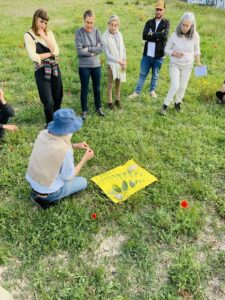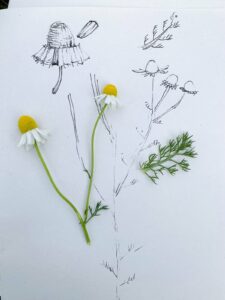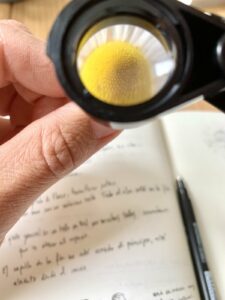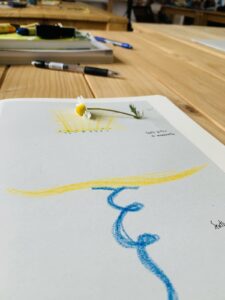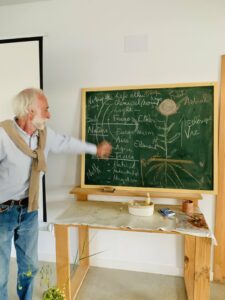At the beginning of May, the Muchada-Léclapart team participated in a training on the Goethean approach to the plant world carried out by the botanist Jean Michel Florin, director of the agriculture section of the Goetheanum and organized by the biodynamic farm Entheos, in Lerin ( Navarre). We share some reflections here and invite you to delve deeper into this topic in the existing bibliography (at the end of the article).
Johan Wolfang Goethe, the “German Cervantes”, the great playwright, author of Faust, developed a unique method for perceiving nature. This was different from the Cartesian materialist developed by Descartes, Galileo or Newton, which was the one that finally triumphed in the development of contemporary thought. Descartes’ paradigm was based on taking from nature only what was measurable and separable, translating the complexity of a life into the simplicity of a machine. This approach promoted and allowed great scientific and technological developments to be carried out, overcoming the subjectivity and superstition that had limited human knowledge until then. However, it also meant a loss, since it involved separating oneself from nature, in order to understand and dominate it, and reduce the complexity of life to its most material manifestations.
The consequence of this loss has been a human development and a science that has understood nature as a good to be exploited, forgetting that the human being belongs to it, and that a separation from it could have negative consequences.
With the triumph of the materialist Cartesian approach, we have achieved a very high technological development, however we have lost an important and joyful part of living together on our planet. It is as if we had developed enormously and separately the notes of a song, but with the price of no longer hearing the melody. It has also meant stopping trusting the human ability to feel the melody, outsourcing that ability to measuring instruments, such as a microscope.
Perhaps it was a necessary step, to be able to listen to the melody again, consciously and more accurately, and empower ourselves with technological development for our good and the good of Planet Earth.
The Goethean approach, as opposed to the Cartesian, proposes:
- Understand nature and its phenomena as a whole (and not in parts), including qualitative phenomena as well as utilitarian ones.
- Trust in the ability of human beings to perceive the environment and the living beings that surround them from their primary senses, their global feeling, their imagination and their intuition.
- Avoid making interpretative theories of natural phenomena, through an explanation via a deep description of the phenomenon itself.
Goethe was a defender of the phenomenological approach, aware of the inevitable participation of the observer in what is observed, and the opportunity that this offers to human beings to achieve higher knowledge. He learned this from reading Spinoza’s texts and from his experience in art and with Italian painters of the 18th century.
In our specific object of study: plants, he assumes understanding their forms, not only as an adaptation to the environment (in the Darwinian sense) but also as a unique expression of the identity of each species and each individual.
Approaching nature and other living beings from the sensitive respect of each identity, each impulse can mean finding solutions to human needs from a place of harmony with its environment. For example, thistle is not conceived as “a weed” but as a bioindicator of a need for the soil of our crop, and with a very precise message of its compaction or a blocked element. Also observing the thistle qualitatively, and not from a utilitarian thought, allows us to perceive its own qualities, regardless of our needs, as well as perhaps observe singular elements of its identity, such as its flowers, perhaps find remedies thanks to them or reflect directly on them. the suitability of our cultivation in that particular location.
If we carefully observe the complex and unique shapes of the leaves, the shape of the stems, the flowers or the fruits of a plant, we can understand that its complexity is not only due to adaptation to the environment. If it were only like that, its shapes would be simple and exclusively functional to fulfill its mission in the plant organism. However, its beauty, its colors, its unique and complex shapes, speak to us of a purpose, an impulse, an identity, a unique solution to being in the world: an inner law of each species.
This internal law is expressed differently depending on the environments in which it can live: depending on the heat or cold, rain or drought, the type of soil, etc… Thus, a chamomile plant can present more or less tall stems, more or less large leaves, more or less bright green. But in all those environments where chamomile can live, the plant will have unique features that determine it as a chamomile, with its hemispherical, yellow flowers or flower buds full of pollen, on white petals.
On the other hand, Goethe proposed that life can only be perceived in movement. That the photograph of a moment is not capable of containing the formative forces that drive the plant to grow as it does. An essential energy to understand the plant but which is not measurable. However, this energy is perceptible from the compression of the movement (metamorphosis) of the plant. In its growth, from the moment it emerges from the seed until it culminates in fruition, like frames from a movie, you can sense the forces that generate it. The problem is that this vital energy can only be perceived from the imagination, from human thinking, which for Goethe is another sense of perception. By educating this human capacity very well, and carefully calibrating it with the senses of sight, smell, taste, touch, the human being can approach this mystery of life. Goethe defended that thought and perception must be as dynamic as life, otherwise it is not possible to capture its mystery; that is, from living being to living being, in a harmonious intellectual breathing, from totality to totality.
Getting closer to this mystery can help us find virtues of plants that humans can use for their well-being, such as their medicinal use, or to understand the needs of a crop or the opportunities of a farm. Making a simile would be like finding a young Picasso and understanding his way of understanding the world and art. And instead of forcing him to carry out a certain style, because it benefits us, we encourage him to develop his unique and brilliant vision of his painting. That is, seeking dialogue and collaboration with nature.
But this way of approaching the plant world has a greater gift for human beings: it helps them foster a feeling of belonging and connection with it. Goethe argued that we can only see what we somehow are, that we carry inside. We cannot see what we are not. If we did not have an idea of a plant inside, we would not be able to see or distinguish it in reality. In other words, looking at the plant world in this way allows us to know ourselves better, and establish an ethical and joyful dialogue with nature, promoting human development in balance with its environment.
One of the worst consequences of the Cartesian approach has been to confuse human beings, making them believe that they do not belong to their environment and that they can dominate them for their use and benefit. This has promoted a development model in imbalance with nature and with Humanity itself. No matter how much we develop technologically, if we do not change our approach, we will end up in an environment uninhabitable by humans.
We leave you here some bibliographical references to continue learning together:
- Rencontrer les plantes. Jean Michel Florin. Editorial Amyris
- Goethe y su visión del mundo. Rudolf Steiner. Editorial Rudolf Steiner
- La metamorfosis de las plantas. Johan Goethe. Editorial Atalanta
- La teoría de la naturaleza. Johan W. Goethe. Editorial Tecnos
- La naturaleza como totalidad. Henry Bortoft. Editorial Atalanta
- https://www.bio-dynamie.org/biodynamie/presentation/approche-goetheenne/#
